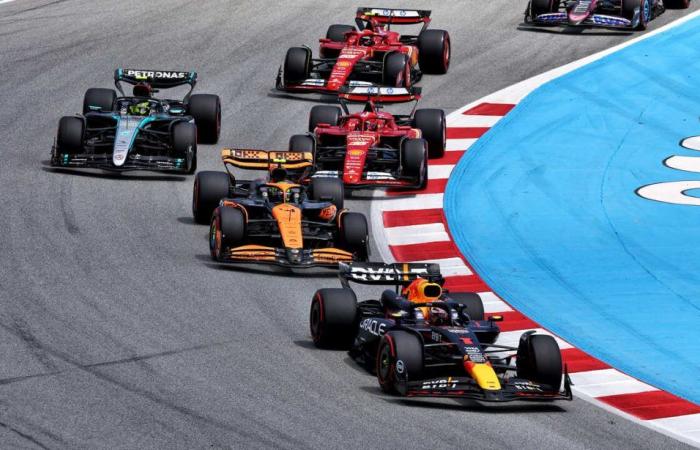Verstappen and Red Bull wall cannibals
The Spanish Grand Prix was an interesting race and fun in its own way, although extremely tactical and strategic. This is already news, given that the Barcelona track is historically one of the most soporific events of the season and illustrates the high level (and consequent leveling) of the 2024 Formula 1, which continues to see Verstappen as the winner, but more for his old-time talent than for his Red Bull, no longer as dominant as in the recent past. The reference single-seater was also McLaren in Barcelona, particularly that of Norris, a truth not hidden by the British driver himself and by the race data that we will see below.
The Woking team and Norris continue to lack a certain ability to realize the real potential of the car, with errors or uncertainties in the crucial phases of the race, an aspect for which, instead, Verstappen and Red Bull prove exceptionally “cannibals” at every opportunity. In fact, the Dutchman won the race in the first laps, first overtaking Norris at the start and then overtaking George Russell in the first laps, which occurred with a speed difference of 30 km/h at the end of the straight (326 for Verstappen, 296 for Russell) which derived both from a very fast hybrid map but also from Verstappen’s ability to stay close to Russell in the last corner, very delicate on tire management but decisive for what then happened at the end of the straight.
Norris first attempted to contain Verstappen at the start, but with an aggressiveness that turned out to be clumsy, so much so that Verstappen even ended up on the grass, and which goes hand in hand with the departure of Sprint in China. Then, once behind Russell, the number 4 McLaren couldn’t find a way to overtake, leaving Verstappen to extend his lead to around 5 seconds, crucial results at the end of the race. Norris then demonstrated, once again, that he is one of the best drivers on the grid in terms of race pace and tire management. In this aspect it could be said that he is almost competing with Verstappen, but to realize the current potential of the car he also needs of the so-called “racecraft”, i.e. the driving technique in close contact with the opponents, given that in this leveled Formula 1 every small episode makes a macroscopic difference on the final result.
Mercedes improves and takes advantage of a Ferrari that is growing too little
Behind the two star performers of the moment, both of whom have left abysmal gaps on their respective teammates, we find the two Mercedes, which in Barcelona show a significant improvement above all because it was raced in the heat and on the Spanish track you need aerodynamic load and a rigid and low set-up compared to the ground, a diametrically opposite situation compared to Canada, which therefore certifies the step forward by the Brackley team, even if Hamilton spoke of a car that finds the ideal window with only one type of set-up. What gives Wolff and his teammates confidence is the fact that Mercedes has not yet brought a truly large package of updates like its rivals, an aspect which, now that the way seems to have been found, could materialize within a few races, bringing further and perhaps even more significant steps forward. However, highlighting Mercedes’ growth is also highlighted by Ferrari’s lack of growth. Hamilton and Russell finished the race, in fact approximately 18 and 22 seconds behind the winner Verstappen, closer than in the first races of the season, but still definitely out of contention for victory. If the reds had shown a performance closer to expectations, i.e. no more than 5-10 seconds behind the top, the Brackley team would hardly have reached the podium, but the reality is that the Spanish trip was a complicated page of the season of the Maranello team. According to what was reported by the red team’s technicians, the Imola package served to redesign the aerodynamic map of the SF24, bringing it to a new concept with greater margins for development, to be exploited with subsequent updates. And the first part of these consequent steps arrived in Barcelona, but the results have appeared below expectations. The main aims were to increase load and efficiency, but we saw a Ferrari that was more unloaded than the competition, with Sainz and Leclerc being the only ones in qualifying to lift their foot in turns 3, 9 and 14, without however being the best in terms of speed. tip. In the Ferrari garage there was talk again about aerodynamic rebound in fast cornersan aspect which probably forced the team to lift the car from the ground, losing both load and efficiency, but which is worrying, given that this phenomenon was now taken for granted and defeated, and which brings with it notable problems from the point of view of the search for performance, as seen at Montmelò.
The data speaks of Red Bull and Ferrari in a tenth, but McLaren definitely ahead
Looking at the data and trying to eliminate as much as possible the episodes that created important gaps, we notice something interesting. For example, comparing Verstappen and Leclerc from the moment of the latter’s first pit onwards we discover that the Monegasque returned to the track with a delay of 19.996 seconds from Verstappen on lap 24, and closed the race with a delay of 22.709 seconds, with an average of just 66 thousandths per lap to the Dutchman’s advantage. Even comparing only the last stint on soft tyre, run in decidedly similar conditions between the two cars, with both drivers pushing hard and with new rubber for Verstappen, we find that the average is just 1 tenth in favor of the champion. World. A gap that therefore opened with the first stint of the race where Leclerc and Ferrari tried (understandably) to create a strategic difference with the cars in front, but which in reality in the lap data would be definitely within the limits of the permissible. It should also be underlined Leclerc’s excellent race, faster than Sainz not only due to strategy, given that the Spaniard was never able to make the medium tire work, unlike Leclerc who showed no difficulty with that compound. Returning to the performances, the problem is, however, who showed the better averagesbeyond the initial phases, was precisely the McLarenwith Norris who practically did the same race as Leclerc from a strategic point of view and who however gave him over 2 and a half tenths per lap on average from the first pit onwards, an already more important gap, especially in such a level season where a tenth is enough to quickly climb positions. This also gives you an idea of how McLaren ultimately had over 1.5 tenths of an advantage over Red Bull which they didn’t exploit and what a huge difference they made. qualifying, start and first stint. To give a further figure Norris achieved the fastest lap with almost 7 tenths ahead of Verstappenin similar conditions in the final stint and with Verstappen using new soft tyre. Now, in conclusion, a doubt arises, of a technical but general nature. At the presentation of the RB20, the Red Bull engineers clearly spoke of a revolutionized concept because they understood that the old road did not have enough development ahead of it. A few months later the announcement of the aerodynamic revolution also arrived at Ferrari, with timing congruent with the delay in research that the teams chasing Red Bull had after the 2023 season. The aerodynamic concept of the SF24 would have come closer to that of the RB20 “to open up new avenues of development”, with words that seemed to echo those coming from Milton Keynes at the beginning of the season, and from there the Imola package was born. The impression was therefore that in Maranello they were retracing the stages already undertaken in Milton Keynes, but today some doubts arise when seeing the performances of both cars. Obviously the RB20 emerged victorious from Barcelona, while Ferrari had to settle for miserable fifth and sixth positions, but we saw that Verstappen’s pace advantage wasn’t actually that large and, above all, what the two teams have in common at the moment seasonal it is the struggle to progress furtherdespite the important updates brought to the track.
McLaren has resumed the natural growth path on which it had been too conservative in the winter
McLaren is the only one who has made a major step forward from Miami onwards, and on it it must be said that in reality their route had perhaps been a little too conservative in the winter, so much so that the SF24 had started the season ahead of the MCL38, but it was quite clear that in Woking what had not been fully developed initially but was then completed and put into the car during the current season, bringing the car back to the natural growth path that began halfway through the last season. Behind McLaren, however, neither Red Bull nor Ferrari have, for now, managed to keep up, with the red team also having a performance deficit which, albeit minimal, places it in an area reachable by the growing Mercedes, as happened in Spain. And here we return again to the words of Andrea Stella in Imola: McLaren’s great strength is correlation, a key technical aspect that seems to be wavering at the moment both for Red Bull (which arrives on the track with set-ups prepared on the simulator which almost always have to be revolutionized during the weekend) and for Ferrari (with forecasts for Barcelona to fight for the victory and increase load that did not come true). Don’t take us for crazy if we lump together the fate of these two teams, but the fact is that we believe that beyond the episodes, and the ability to always make the most of everything of Verstappen and the Red Bull team, technically the two teams are experiencing a moment of growth flattening not so dissimilar and for this both teams need to work intensely to avoid finding themselves in a dead end.






